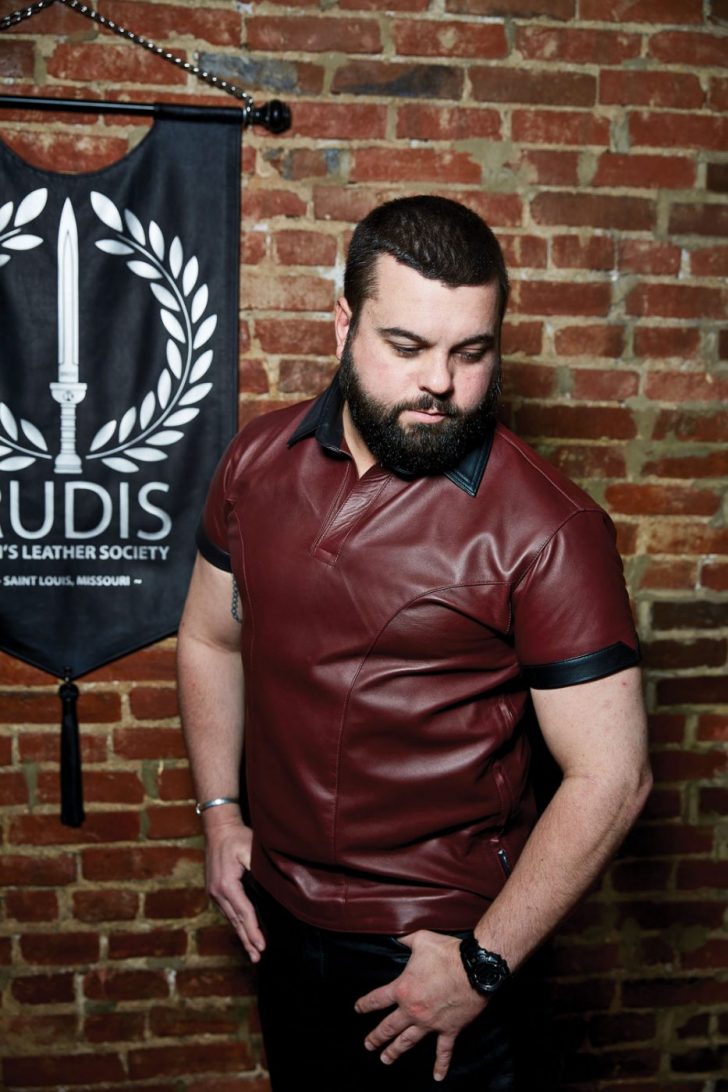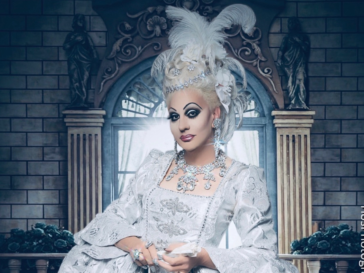“More leather cycles through here in a week than most people will see in ten lifetimes,” says Thom Glowski as he looks around the workshop in the basement of the home he and his husband share in south city.
Home to his business, LDD Leather Works, the workshop is where the self-taught leather maker creates harnesses, suspenders, arm bands, wrist cuffs, leg harnesses and vests. There are long work tables, male torso mannequins, a garment rack where a few in-progress pieces hang. Adjustable lamps hover over three industrial sewing machines, while the back wall displays samples that represent a relatively recent departure from the leather community’s all-black ethos of years past: leather in various colors. On an adjacent wall, an inventory of shiny metal rings hangs on white pegboard.
The space, like its occupant, is bright and orderly. “I don’t wear leather anymore,” says Glowski, adding that he prefers his best creations be worn instead by his customers. “I live it.”
An active player in the St. Louis leather scene since he was 22, Glowski recently turned 54. He believes his communication skills are the main reason he’s considered a pillar of the community. “I can talk to people one on one,” he says. “I explain leather. We talk about styles, what to wear, attitudes.”
To aspirants, Glowski provides an education on the leather community’s values, such as silent strength and confidence. “I’m a leather maker and a mentor,” he says. “I build leather men. I take a person under my wing and help him become more a more well-rounded leather man.” He also works with apprentices who want to become leather makers, sharing wisdom acquired throughout a career that started with him teaching himself to make leather saddlebags and fender guards.
But he does a lot more than talk, teach and observe: He organizes.
In 2016 he was one of the founding members of Rudis Men’s Leather Society. The group takes its name from the wooden swords that were given to gladiators when they were granted their freedom. Glowski believes that emphasizing and celebrating freedom is one of the most important ways Rudis differentiates itself from other organizations, many of which still adhere to the tradition of admitting new members on an invitation-only basis.
“Rudis is open to anyone who is interested in leather,” he says. “We have a social twice a month where everyone is welcome. Don’t expect kink parties or a dungeon night, but you can learn about events that are all over the country. You can learn about different leather makers. And if you want to learn about a specific activity, we can introduce you to a sir who is an expert.”
Glowski is particularly proud that the group doesn’t exclude based on age or gender. “You can be 60 or 85 years old, and if you look hot in leather, you’re welcome to be a hot daddy and absolutely nobody is going to give a shit about your age,” he says. In addition, based on a vote of the members, Rudis is open to cisgender women and non-binary and trans people.
The emphasis on learning about individual interests rather than a strict adherence to traditional rules and regulations clearly strikes a chord – Rudis has 45 active members and almost 700 followers on Facebook. Based on the calls he gets from people wanting to launch similar organizations in other locations, Glowski considers Rudis a leather incubator. While Rudis emphasizes welcoming newcomers, the group also has four sirs – an earned designation – in its ranks.
Most importantly, Glowski says that Rudis does not tolerate discrimination on any level. “There’s not a single mean bone in anyone’s body,” he says. “If someone rolls his eyes at what someone is wearing, they’re going to hear about it.”

While the leather scene in general – and Rudis in particular – is evolving, some things remain relatively unchanged. Leather men are generally not what you’d call cuddly, Glowski says. And generally, they’re alpha males. “That’s changing, but gradually,” he says.
A few more traditional members of the community aren’t down with Rudis’ freestyle approach to leather. Glowski says that some even find fault with the group’s home bar, the popular but unassuming Bar PM, a cozy, soft-lit establishment known for lively drag shows, that’s tucked into the emerging mini-gayborhood on South Broadway near Blow Street.
“I’ve heard some people say that even our setting isn’t authentic, that Bar PM isn’t even a real gay bar,” he says. “You’re right. It’s not. It’s not dark and dank and it doesn’t smell like urine and someone’s not getting fucked in the corner. It’s 2019, and you can’t do that anymore.”
Rudis owes its formation in part to one of St. Louis’ legacy leather organizations folding, leaving only one group in the area – one that many felt they weren’t “leather enough” to join. “The people we had in mind when we formed Rudis were looking for something a little lighter, a little more entry level,” Glowski recalls.
While the group’s inherent openness gives it a decidedly modern feeling, the roots of Rudis actually run deep in tradition. Glowski is an avid historian who has been part of the leather community for more than three decades. Whether teaching himself to create leather wear on his first Wal Mart-bought sewing machine, reading books on the history of leather, traveling the country and the world with his husband, or attending an array of leather events, Glowski is a keen observer and cataloger of details.
“I ask questions wherever I go,” he says as he recounts the origin and evolution of what’s known today as the leather community.
Male leather as a subculture is popularly believed to have started in the 1940s, as thousands of young men returned from World War II and joined what were then mostly heterosexual motorcycle groups. That first era – or genre, as periods in the leather community’s evolution are called – is known as First Guard. Leather got its start as a comparatively formal, rules-based affair; it was a community one had to be invited to join, for example, and whose norms dictated that leather clothing and gear was gifted rather than purchased.
Other genres include First Guard, New Guard and New School. Puppies, thought of by many cultural critics as the new kids on the kink block, are a millennial manifestation of leather: very few rules, and very mild – if any – power differentials exist between the pups and their handlers. “The Old Guard has more rules around collaring, boys and sirs, how you wear your Sam Brown,” Glowski says. “The Puppies are such a young community that they’re still working out what the rules are.”
As is the case in many communities, the more recent the iteration, the more liberal. “If you put on a leather dress and some spiked boots, lots of traditional from earlier genres would say that’s not even leather,” Glowski says. “Some puppies, on the other hand, would say, great, here’s a mask to add.”
Glowski believes leather has prevailed through times as docile as the 1950s and as turbulent as the Vietnam era and the rise of the AIDS epidemic because it’s centered around humankind’s all-time favorite subject: sex. “It’s about sex, and it’s about giving and taking power,” Glowski says. “It’s often hard to go to your partner and say you want to try something new.”
Not so in the leather community, where those who want to explore new territory are introduced to a sir who is an expert on whatever the interest happens to be, and that sir then assumes responsibility for making sure the experience is both safe and good. “It’s about relinquishing sexual control,” Glowski says. “Worlds open. If this were common practice, everyone would be a lot happier.”
As worlds were opening in various ways, somewhere along the line the leather and the kink communities bonded and, as Glowski puts it, “became one. That’s because everyone is at least a little kinky, and the missionary position is boring as shit,” he says. “Everyone has something that’s off the norm that strikes them and gets them a little woody.”
The joining of the two groups beneath a banner of kink gave rise to the notorious hanky codes, the sexual emoticons of life before the Internet, which signaled what a person was looking for based on the color of the bandana and its placement in the left or right back pocket. Earrings were also used to convey what was being sought or offered.
Glowski believes hanky codes are oversimplified and limiting. “As gay people we categorized our interest, gave it a label and a color and handed it out like Pez candy,” he says. “We should not have done it that.” Glowski believes that once someone is known as a piss queen, for example, that will likely be the only thing people associate him with, which could make exploring new avenues difficult.
Glowski has other, more practical reasons for not being a fan of hanky codes. “They’re left and right,” he says, “while your harness, on the other hand, is symmetrical.” Also, hankies are prone to misinterpretation and tend to ruin perfectly good colors. Brown, for example.

It is Rudis’ annual event – Hell on Heels – that most epitomizes the group’s passion for redefining leather culture while simultaneously embracing its tradition. Hell on Heels takes place at Bar PM the weekend before the official start of Pride and brings together, on one stage, drag queens in leather and leather men in drag. Not surprisingly, it’s a raucous affair, a festive collision of drinking, performing, charity, the hypermasculinity leather is known for, and fabulous heels.
It’s an event that’s also chock full of historical symbolism.
When World War II ended in 1945, thousands of veterans returned to the U.S., where many of them found themselves missing the adrenaline and sense of adventure that combat had provided. More specifically, many of them were lost without the close bonds and the deep sense of camaraderie they’d experienced with other men during their tour of duty. Queer men in particular simply found it difficult, if not impossible, to return to living with the restrictions imposed by the communities from whence they’d come because the war had given them a taste of the larger world. Some were likely suffering from PTSD.
Many of the young men who had spent life-and-death time in trenches throughout Europe returned home, bought a new motorcycle and promptly hit the road. Eventually, a loose affiliation of road houses and biker bars formed, places that were not initially segregated based on orientation. In 1953, in the film The Wild One, Marlon Brando wore jeans, a t-shirt, a leather jacket and a Muri cap, single-handedly inspiring even more young men to reject mainstream culture, jump on a motorcycle and take up a life on the road.
And of course men who migrated to cities instead of back to the farm were liberated to explore the art of female impersonation.
“The war ends, now what?” Glowski asks, his already bright blue eyes beaming with the added excitement of a historian who has reached the heart of his matter. “We’re on the road on motorcycles and they’re performing at the bathhouse.”
And decades later, for one evening in June, on a small stage on South Broadway, an enthusiastic crowd celebrates a joining of forces that feels very much like a family reunion.
To learn more about Rudis, follow the group on Facebook or visit www.rudis-mls.com
Patrick Collins is a freelance writer who lives and writes on the city’s south side. Reach him at [email protected]



